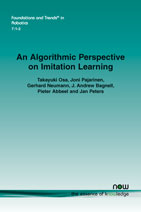An Algorithmic Perspective on Imitation Learning
By Takayuki Osa, University of Tokyo, Japan, osa@edu.k.u-tokyo.ac.jp | Joni Pajarinen, Technical University Darmstadt, Germany, pajarinen@ias.tu-darmstadt.de | Gerhard Neumann, University of Lincoln, UK, gneumann@lincoln.ac.uk | J. Andrew Bagnell, Carnegie Mellon University, USA, bagnell2@andrew.cmu.edu | Pieter Abbeel, University of California, Berkeley, USA, pabbeel@cs.berkeley.edu | Jan Peters, Technical University Darmstadt, Germany, mail@jan-peters.net
Abstract
As robots and other intelligent agents move from simple environments and problems to more complex, unstructured settings, manually programming their behavior has become increasingly challenging and expensive. Often, it is easier for a teacher to demonstrate a desired behavior rather than attempt to manually engineer it. This process of learning from demonstrations, and the study of algorithms to do so, is called imitation learning. This work provides an introduction to imitation learning. It covers the underlying assumptions, approaches, and how they relate; the rich set of algorithms developed to tackle the problem; and advice on effective tools and implementation. We intend this paper to serve two audiences. First, we want to familiarize machine learning experts with the challenges of imitation learning, particularly those arising in robotics, and the interesting theoretical and practical distinctions between it and more familiar frameworks like statistical supervised learning theory and reinforcement learning. Second, we want to give roboticists and experts in applied artificial intelligence a broader appreciation for the frameworks and tools available for imitation learning. We pay particular attention to the intimate connection between imitation learning approaches and those of structured prediction Daumé III et al. [2009]. To structure this discussion, we categorize imitation learning techniques based on the following key criteria which drive algorithmic decisions:
1) The structure of the policy space. Is the learned policy a time-index trajectory (trajectory learning), a mapping from observations to actions (so called behavioral cloning [Bain and Sammut, 1996]), or the result of a complex optimization or planning problem at each execution as is common in inverse optimal control methods [Kalman, 1964, Moylan and Anderson, 1973].
2) The information available during training and testing. In particular, is the learning algorithm privy to the full state that the teacher possess? Is the learner able to interact with the teacher and gather corrections or more data? Does the learner have a (typically a priori) model of the system with which it interacts? Does the learner have access to the reward (cost) function that the teacher is attempting to optimize?
3) The notion of success. Different algorithmic approaches provide varying guarantees on the resulting learned behavior. These guarantees range from weaker (e.g., measuring disagreement with the agent’s decision) to stronger (e.g., providing guarantees on the performance of the learner with respect to a true cost function, either known or unknown). We organize our work by paying particular attention to distinction (1): dividing imitation learning into directly replicating desired behavior (sometimes called behavioral cloning) and learning the hidden objectives of the desired behavior from demonstrations (called inverse optimal control or inverse reinforcement learning [Russell, 1998]). In the latter case, behavior arises as the result of an optimization problem solved for each new instance that the learner faces. In addition to method analysis, we discuss the design decisions a practitioner must make when selecting an imitation learning approach. Moreover, application examples—such as robots that play table tennis [Kober and Peters, 2009], programs that play the game of Go [Silver et al., 2016], and systems that understand natural language [Wen et al., 2015]— illustrate the properties and motivations behind different forms of imitation learning. We conclude by presenting a set of open questions and point towards possible future research directions for machine learning.
An Algorithmic Perspective on Imitation Learning
As robots and other intelligent agents move from simple environments and problems to more complex, unstructured settings, manually programming their behavior has become increasingly challenging and expensive. Often, it is easier for a teacher to demonstrate a desired behavior rather than attempt to manually engineer it. This process of learning from demonstrations, and the study of algorithms to do so, is called imitation learning.
An Algorithmic Perspective on Imitation Learning provides the reader with an introduction to imitation learning. It covers the underlying assumptions, approaches, and how they relate; the rich set of algorithms developed to tackle the problem; and advice on effective tools and implementation.
An Algorithmic Perspective on Imitation Learning serves two audiences. First, it familiarizes machine learning experts with the challenges of imitation learning, particularly those arising in robotics, and the interesting theoretical and practical distinctions between it and more familiar frameworks like statistical supervised learning theory and reinforcement learning. Second, it provides roboticists and experts in applied artificial intelligence with a broader appreciation for the frameworks and tools available for imitation learning. It pays particular attention to the intimate connection between imitation learning approaches and those of structured prediction.
